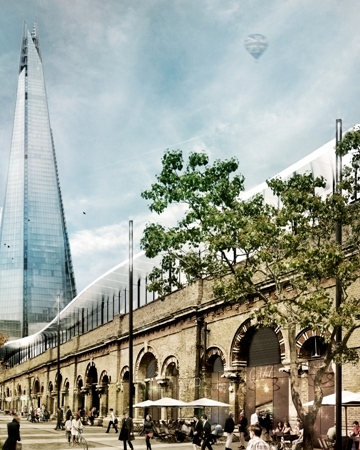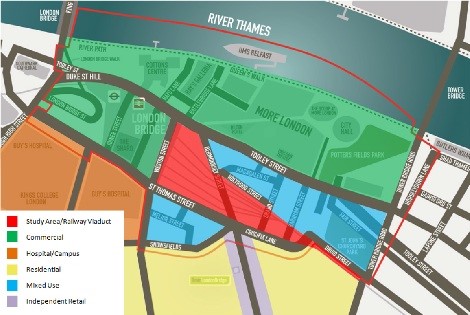The capital’s oldest railway terminus is today the location of two of the UK’s most prestigious and ambitious construction projects. The £1.5billion London Bridge Quarter development and £700million London Bridge station project bring enormous investment to a location dominated by its historic railway infrastructure, a feature that both defines and divides the community in equal measure.
In combination with Southwark Council and other south London Business Improvement Districts, Team London Bridge has been developing the concept of the 'Low Line'. Borrowing from New York's enormously successful High Line, the Low Line's ambition is to use the 4 miles of railway viaduct between Vauxhall and Bermondsey to create a new cultural and economic destination.
The arches themselves will be activated, tenanted and programmed to support small businesses and enliven street frontages, whilst exemplary public realm will create new walking and cycling routes and green spaces.
Our focus is primarily on the section of viaduct between London Bridge station in the west to Tower Bridge Road in the east.

Key objectives:
- Provide and protect space for small, independent businesses.
- Connect major attractions such as Borough Market and Maltby St / Druid St Market.
- New walking and cycling routes adjacent to the viaduct.
- Ensure the business mix serves the needs of the neighbouring communities (business, visitor and residential).
- Deliver a coherent, high quality public realm that priorities tree planting, sustainable urban drainage and new public green spaces.
Why now?
The successful redevelopment of King’s Cross and St Pancras railway stations illustrates how these revived transport hubs catalyse and incorporate regeneration in the wider area. The new London Bridge station will transform the area for the next 100 years and without a structured approach the opportunity for the community to shape the future will be squandered.
There is a once in a generation chance to create an original, culturally significant, sustainable scheme that unifies what is presently an area of two differing identities. London Bridge is the focus of global attention that may never again be repeated creating a unique opportunity to capitalise on potential investment, both creatively and financially.
This project endeavours to provide not only a strategy to utilise these fantastic assets for the benefit of all stakeholders, but has the potential to create a template for the many similar urban communities across the UK.
What Next?
The Low Line project now sits within the
London Bridge Plan (a planning framework developed in conjunction with Southwark Council) and also the Draft New Southwark Plan (the council's statutory planning policy document for the Borough).
Background - Arches & Tunnels Research Project
The London Bridge Low Line began in 2013 with a research collaboration
between London South Bank University and Team London Bridge which examined the feasibility of creating an arts, crafts and technology (ACT)
cluster within these unique spaces, utilising this landmark feature to
compliment the flourishing communities that surround it. The emphasis of the
cluster would focus on the importance of ‘making’, ‘selling’ and ‘educating’,
whilst also developing the synergies between arts, crafts and technology. This final proposal was titled 'Made in London Bridge'.
The arches and
tunnels could be completely transformed to create active street frontages and
provide access to the cavernous space beyond which offers opportunities for a
multitude of uses. St. Thomas Street, Holyrood Street, Druid Street and
Crucifix Lane have the potential to become thriving high streets both day and
night with an offering of retail, leisure and light manufacturing.

Map of study area
(red)
Outcomes and
benefits
Improving the
physical environment
• Physical restoration would improve public security and perception of
public safety, revive one of London’s heritage assets, create a more
attractive, safe place to live and work, and better facilitate pedestrian
movement north to south.
Create a vibrant
place to live and work
• A good range of amenities such as bars, restaurants, retail and other
leisure activities and the general ‘buzz’ of a place all create an
enjoyable working environment.
• Just 27% of the local business community would describe London Bridge as
‘a vibrant area’ (user panel Dec 2011). The introduction of a creative and
cultural cluster would greatly improve the vibrancy of the area as they have
proven to be very effective at providing a convivial atmosphere.
Providing a coherent
business strategy
• Organising inter-related and complementary businesses into clusters
makes them more innovative, profitable and efficient - and thus stronger
tenants.
• Clusters are highly attractive locations for new businesses which
increases the speed and ease with which premises can be let.
• A coherent cluster of businesses helps form an identity and sense of
place which can be used to market the area, complimenting current businesses
within London Bridge and Bermondsey.
Improve the retail
offering
• Surveys conducted by Team London Bridge show a concern amongst the
business community over the lack of retail in the area. Businesses selling or
making art, craft and artisanal products would address the desire for
independent, characterful retailers.
• This would allow Network Rail to fulfil its Section 106 planning
obligation of providing affordable business space for independent retailers
along St Thomas Street for a five year period.
Addressing socioeconomic
problems
• The creative industries show encouraging growth despite the recent
recession and provide opportunities for employment. For example, the creative
industries accounted for 4.99% of UK employment in 2009, increasing to 5.14% in
2010. Employment in the heritage crafts sector is forecasted to rise 12%
between 2012 and 2022.
Other benefits will
include:
• Restoring
lost heritage
• Becoming a ‘destination’ in its own right
• Allowing Bermondsey Street community to expand
• Linking with developments in the wider area
• Capitalising on increasing visitor numbers to London Bridge
• Accommodating flexible lease structures
• Conforming to planning policy